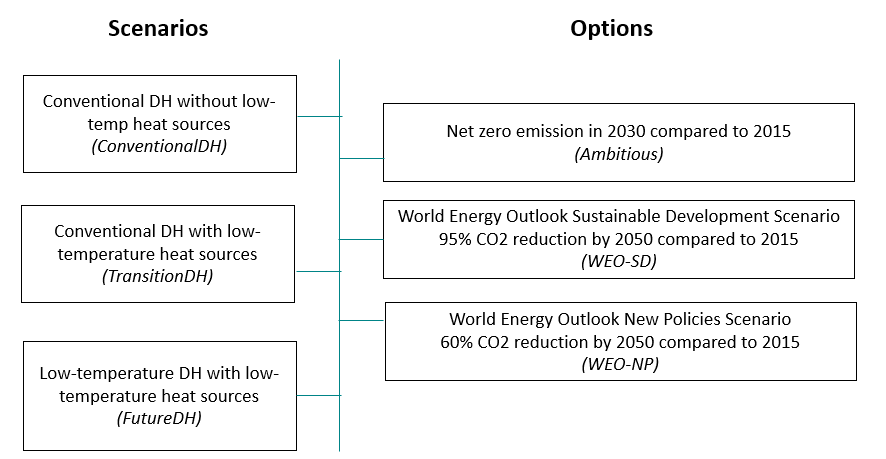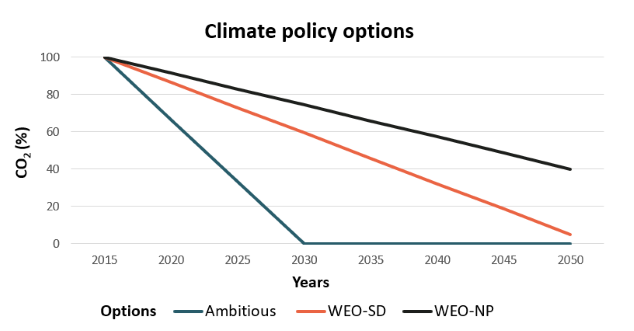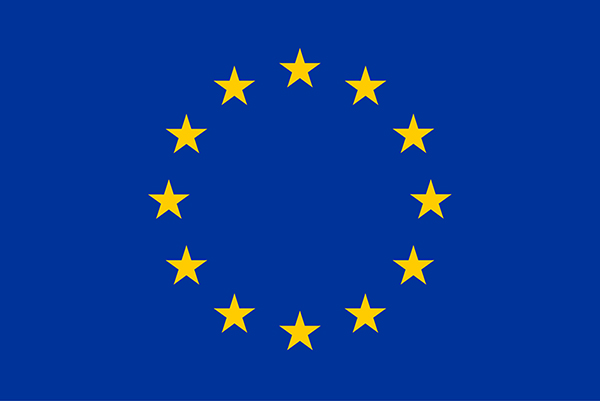













REWARDHeat scenario description
For the purposes of RewardHeat project, 9 senarios were developed and modeled in TIMES model generator. These 9 scenarios result from a combination of 3 heat supply scenarios and 3 climate policy options.

Three heat supply scenarios
Conventional DH - Conventional district heating without low temperature heat sources In this scenario, the current DH systems remain without low temperature heating sources.
Transition DH - Conventional district heating with low temperature heat sources In this scenario, the current DH systems remain. In additon to this low temperature heating sources are introduced to the system.
Future DH - Low Temperature district heating with low temperature heat sources Low temperature district heating technologies are introduced with the availability of low temperature heating sources.
Three climate policy options
Ambitious - Net zero emission by 2030 compared to 2015 Local and international CO2 emission reduction of 100% by 2030 compared to 2015
WEO-SD - World Energy Oulook Sustainable Development Scenario total CO2 reduction by 95% by 2050 compared to 2015 Local and international CO2 emission reduction of 95% by 2050 compared to 2015
WEO-NP - World Energy Oulook New Policies Scenario total CO2 reduction by 60% by 2050 compared to 2015 Local and international CO2 emission reduction of 60% by 2050 compared to 2015

Key aspects of scenarios for each option
Conventional DH + Ambitious
- High rate of heat demand reduction by 2050
- Local and international CO2 emission reduction of 100% by 2030 compared to 2015
- Faster rate of renewable electricity generation by 2050
- Lower cost of fossil fuels and higher cost of biomass
- Lower DH network investment costs and higher losses
- Lower efficiencies of biomass and natural gas CHPs and boilers
- No large-scale heat pumps
Conventional DH + WEO-SD
- High rate of heat demand reduction by 2050
- Local and international CO2 emission reduction of 95% by 2050 compared to 2015
- Faster rate of renewable electricity generation by 2050
- Lower cost of fossil fuels and higher cost of biomass
- Lower DH network investment costs and higher losses
- Lower efficiencies of biomass and natural gas CHPs and boilers
- No large-scale heat pumps
Conventional DH + WEO-NP
- Low rate of heat demand reduction by 2050
- Local and international CO2 emission reduction of 60% by 2050 compared to 2015
- Slower rate of renewable electricity generation by 2050
- Higher cost of fossil fuels and lower cost of biomass
- Lower DH network investment costs and higher losses
- Lower efficiencies of biomass and natural gas CHPs and boilers
Transition DH + Ambitious
- High rate of heat demand reduction by 2050
- Local and international CO2 emission reduction of 100% by 2030 compared to 2015
- Faster rate of renewable electricity generation by 2050
- Lower cost of fossil fuels and higher cost of biomass
- Lower DH network investment costs and higher losses
- Lower efficiencies of biomass and natural gas CHPs and boilers
- Lower COP of large-scale heat pumps
Transition DH+ WEO-SD
- High rate of heat demand reduction by 2050
- Local and international CO2 emission reduction of 95% by 2050 compared to 2015
- Faster rate of renewable electricity generation by 2050
- Lower cost of fossil fuels and higher cost of biomass
- Lower DH network investment costs and higher losses
- Lower efficiencies of biomass and natural gas CHPs and boilers
- Lower COP of large-scale heat pumps
Transition DH + WEO-NP
- Low rate of heat demand reduction by 2050
- Local and international CO2 emission reduction of 60% by 2050 compared to 2015
- Slower rate of renewable electricity generation by 2050
- Higher cost of fossil fuels and lower cost of biomass
- Lower DH network investment costs and higher losses
- Lower efficiencies of biomass and natural gas CHPs and boilers
- Lower COP of large-scale heat pumps
Future DH + Ambitious
- High rate of heat demand reduction by 2050
- Local and international CO2 emission reduction of 100% by 2030 compared to 2015
- Faster rate of renewable electricity generation by 2050
- Lower cost of fossil fuels and higher cost of biomass
- Higher DH network investment costs and lower losses
- Higher efficiencies of biomass and natural gas CHPs and boilers
- Higher COP of large-scale heat pumps
Future DH+ WEO-SD
- High rate of heat demand reduction by 2050
- Local and international CO2 emission reduction of 95% by 2050 compared to 2015
- Faster rate of renewable electricity generation by 2050
- Lower cost of fossil fuels and higher cost of biomass
- Higher DH network investment costs and lower losses
- Higher efficiencies of biomass and natural gas CHPs and boilers
- Higher COP of large-scale heat pumps
Future DH + WEO-NP
- Low rate of heat demand reduction by 2050
- Local and international CO2 emission reduction of 60% by 2050 compared to 2015
- Slower rate of renewable electricity generation by 2050
- Higher cost of fossil fuels and lower cost of biomass
- Higher DH network investment costs and lower losses
- Higher efficiencies of biomass and natural gas CHPs and boilers
- Higher COP of large-scale heat pumps



